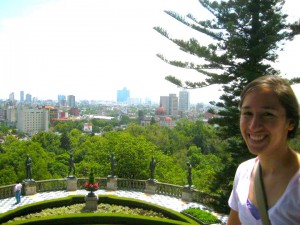I am Mexican-American, born on the border between the countries to two immigrant working-class parents. My ancestry in Mexico not only drove me to want to learn more and experience living in Mexico, but also drew me to examine both sides of my identity and the mutually beneficial process of cross-cultural communication. Mexican-Americans and Mexican immigrants are great bridges for creating mutual understanding between the United States and Mexico, who continue to influence each other today.
When I was thinking about applying for the Fulbright U.S. Student Program Study/Research grant, I knew I was interested in humanitarian design in order to address pressing social issues. I wanted an opportunity to explore the creation of imagery, artifacts, and educational tools to create awareness and dialogue. I knew that I wanted to travel to a place where I was proficient in the language, where I could understand not only the definitions of the words that were spoken to me, but the personality and soul in which these words and conversations were being spoken. As such, Mexico was a perfect fit.

Nancy Guevara, 2011-2012, Mexico (right), and two artists of the Puebla Ciudad Mural celebrating after finishing their intensive one week creation in Puebla, Mexico
I designed my project around working with a social design non-profit organization, Razón Social, to create design projects that involved communities and addressed issues of sustainability, education, and poverty. Throughout my time in Mexico, my project changed and developed according to the resources we found, the ties I created, and the projects that were active. Razón Social served as a starting point for my interactions with the community and my social design work in Mexico. Early on, I realized that my project depended greatly on the connections and resources I made within the community.
As I made connections with organizations and individuals, my Fulbright project took shape, encompassing my areas of focus and my interest in working with communities. My projects included an interactive storybook for pediatric cancer patients, a workshop on image creation based on social justice, a didactic arts-based activity for high school students, and a mural that depicts the rejuvenation of a neighborhood through its children.
I found that as a cultural worker and designer, being present was the most impactful thing of all. During my time in Mexico, I tried to think of the community as a classroom and myself as a resource. One year wasn’t enough to affect dramatic and lasting changes through social design. One year wasn’t enough to fully understand a community, much less a culture. Yet one year was more than enough to create dramatic and lasting changes in me. The projects I worked on sparked dialogue, ideas, and awareness within the people that were involved and interacted with the result. I made some great friendships and connections, connections with which I made a meaningful contribution.
Words of advice for a successful Fulbright application:
-If your project proposal is individualistic in nature, consider including ways to involve your local host community.
-Consider thinking about how your project could directly benefit other people. How will your project positively affect the community?
-You are not a savior, you are a resource.
Have a specific question about Mexico or want to learn more about Nancy’s experience? Contact her at NGuevara.AlumniAmbassador@fulbrightmail.org, or visit nancyedithguevara.org.


No Comments